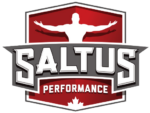The single leg squat from a box is one of our go-to exercises at Saltus not only for developing single leg strength, but also as an assessment tool to gauge the athletes’ movement quality which includes their mobility, stability, and level of symmetry between their right and left sides.
To safely and effectively perform the single leg squat from a box, the athlete will require both mobility & stability at the hip, knee, and ankle. To achieve the same number of reps with the same amount of added load, the athlete will require symmetrical levels of strength in both legs.
If you’re performing these without the help of a coach, assess your own movement quality by setting up a camera from a front 45 degree angle and record yourself.
What to look for
Feet and ankles: At the foot, you should not have any pronation or supination, and your weight should be evenly distributed through your big toe, baby toe, and heel. This will effectively turn your foot into a tripod. During the single leg squat, your heel should never come off of the box.
Knees: Your knees should not display any valgus (i.e knee turning inwards). During the single leg squat, your knee should remain stacked overtop of your foot. It is okay for the knee to move past the middle of your foot and even your toes as long as your heel does not come off of the box.
Hips/pelvis: Your hips should remain in-line with your knees and ankles. During the single leg squat, your hips should not shift outwards to the sides, but rather solely backwards as you descend deeper into the squat. Your pelvis should remain in a neutral position, avoiding posterior or anterior pelvic tilt.
Spine & shoulders: Your spine should remain long and flat throughout the entire movement. During the single leg squat your shoulders blades should remain pulled back and apart.
If you notice any discrepancy in movement quality related to the strength, mobility, or stability between your left and right legs, then that should help to identify asymmetries that you may want to address to reduce your risk for injury and boost sport performance.
If you need any help assessing your technique, or addressing your imbalances we’re happy to help with in-person services in Vancouver, BC., or online anywhere! We can be reached by e-mail ([email protected]), phone (604-346-5661) or on IG/Facebook (@SaltusPerformance).
